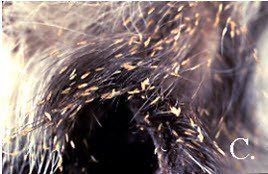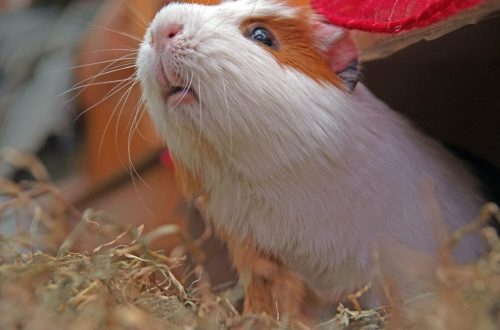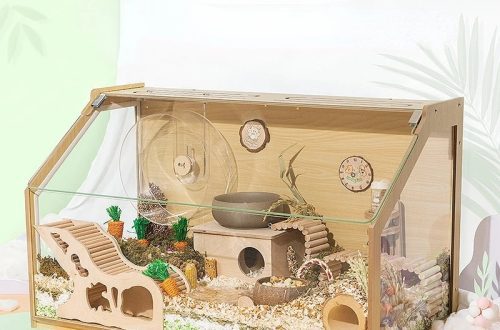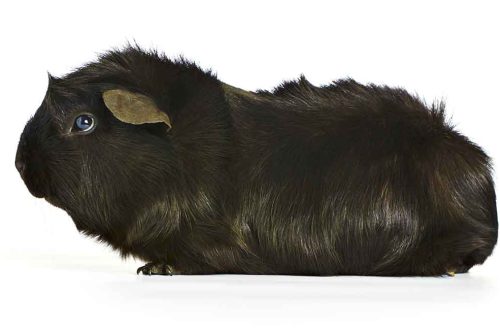
Lice on guinea pigs
Lice are one of the few ectoparasites found in guinea pigs.
The main symptoms are:
- severe itching
- constant scratching
- scratching (excoriation) on the skin.
- the presence of nits in the coat.
Lice are one of the few ectoparasites found in guinea pigs.
The main symptoms are:
- severe itching
- constant scratching
- scratching (excoriation) on the skin.
- the presence of nits in the coat.
If you notice that the guinea pig constantly itches and shows anxiety, it is necessary to examine the skin and coat under a magnifying glass. There may be several reasons. If lice are the cause of the lesion, then nits will be very clearly visible in the wool – pear-shaped testicles 0,5-0,8 mm long, which are glued to the wool with the secretion of the sebaceous gland secreted by females. The insects themselves cling so tightly to the wool that it is impossible to remove them with a brush.
If you notice that the guinea pig constantly itches and shows anxiety, it is necessary to examine the skin and coat under a magnifying glass. There may be several reasons. If lice are the cause of the lesion, then nits will be very clearly visible in the wool – pear-shaped testicles 0,5-0,8 mm long, which are glued to the wool with the secretion of the sebaceous gland secreted by females. The insects themselves cling so tightly to the wool that it is impossible to remove them with a brush.
Contents
How to treat lice in a guinea pig
It is best to consult a veterinarian at the slightest suspicion of infection for a more accurate diagnosis and the appointment of an adequate and safe treatment. Not the best idea would be a trip to the pharmacy for a remedy for lice. Such funds are intended for humans, and exceeding the dosage, which is quite difficult to calculate for a small rodent, can have disastrous consequences. It will be much safer if the veterinarian makes a diagnosis and prescribes drugs and dosages that are safe for guinea pigs.
After treating the guinea pig, it will be necessary to carefully clean the cage, dishes and all things of the pig with water and a small amount of detergent to prevent re-infection. Thoroughly rinse the cage, feeders and drinkers. All textile accessories (hammocks, houses, sunbeds, etc.) will need to be washed and, for reliability, poured over with boiling water (you can freeze in the freezer).
Lice remedies suitable for guinea pigs:
- Stronghold 6%
- Advantage 40 or Advantage 80
- Frontline drops (analogues: fiprist, fiproclear, flevox, fiprex)
- Frontline spray (fiprist spray) should be used as drops on the withers. One of the safest drugs, as they are allowed to treat even pregnant animals
- Baephar, pest control spray
Now in pet stores and veterinary pharmacies there is a large selection of anti-ectoparasites for rodents. It is better, of course, to choose those that are made on the basis of vegetable
Repeat the treatment 2-3 times at intervals of 7-8 days to prevent infection by hatched larvae.
It is best to consult a veterinarian at the slightest suspicion of infection for a more accurate diagnosis and the appointment of an adequate and safe treatment. Not the best idea would be a trip to the pharmacy for a remedy for lice. Such funds are intended for humans, and exceeding the dosage, which is quite difficult to calculate for a small rodent, can have disastrous consequences. It will be much safer if the veterinarian makes a diagnosis and prescribes drugs and dosages that are safe for guinea pigs.
After treating the guinea pig, it will be necessary to carefully clean the cage, dishes and all things of the pig with water and a small amount of detergent to prevent re-infection. Thoroughly rinse the cage, feeders and drinkers. All textile accessories (hammocks, houses, sunbeds, etc.) will need to be washed and, for reliability, poured over with boiling water (you can freeze in the freezer).
Lice remedies suitable for guinea pigs:
- Stronghold 6%
- Advantage 40 or Advantage 80
- Frontline drops (analogues: fiprist, fiproclear, flevox, fiprex)
- Frontline spray (fiprist spray) should be used as drops on the withers. One of the safest drugs, as they are allowed to treat even pregnant animals
- Baephar, pest control spray
Now in pet stores and veterinary pharmacies there is a large selection of anti-ectoparasites for rodents. It is better, of course, to choose those that are made on the basis of vegetable
Repeat the treatment 2-3 times at intervals of 7-8 days to prevent infection by hatched larvae.
Can you get lice from a guinea pig?
No. Rodent lice do not live on humans, so you don’t have to worry about a guinea pig re-infecting everyone in the household with lice. Even if a louse gets on a person, it will quickly die.
No. Rodent lice do not live on humans, so you don’t have to worry about a guinea pig re-infecting everyone in the household with lice. Even if a louse gets on a person, it will quickly die.
The difference between lice and mites
Both lice and mites are ectoparasites. Both lice and mites cause itching and itching in guinea pigs. But mites are arachnids and lice are insects. Both lice and mites are a very unpleasant phenomenon that causes discomfort and inconvenience to both guinea pigs and their owners. But, fortunately, it is easy and simple to get rid of those and others with the help of modern drugs.
For information on how to deal with ticks, read the article “Ticks in guinea pigs”
Both lice and mites are ectoparasites. Both lice and mites cause itching and itching in guinea pigs. But mites are arachnids and lice are insects. Both lice and mites are a very unpleasant phenomenon that causes discomfort and inconvenience to both guinea pigs and their owners. But, fortunately, it is easy and simple to get rid of those and others with the help of modern drugs.
For information on how to deal with ticks, read the article “Ticks in guinea pigs”
Prevention of lice in guinea pigs
The likelihood that guinea pigs that live in an isolated environment and do not communicate with relatives from the outside will catch lice is extremely low.
There is two ways of infecting lice and other ectoparasites:
- poor quality feed and contaminated food
- textile accessories for pigs.
The latter, even if they are made of synthetic materials, can be a carrier of parasites.
The best way to prevent lice from entering your home is to freeze for 24 hours. Freezing food or pig utensils is guaranteed to kill any lice or other ectoparasites you may have brought in from a store or warehouse.
Guinea pigs that communicate with relatives from the outside (stay in hotels, overexposures and shelters) are at risk of infection more than others. Upon returning home, check the hair behind the guinea pig’s ears for nits or lice. There is almost no hair behind the ears, so it is easiest to see parasites here.
The likelihood that guinea pigs that live in an isolated environment and do not communicate with relatives from the outside will catch lice is extremely low.
There is two ways of infecting lice and other ectoparasites:
- poor quality feed and contaminated food
- textile accessories for pigs.
The latter, even if they are made of synthetic materials, can be a carrier of parasites.
The best way to prevent lice from entering your home is to freeze for 24 hours. Freezing food or pig utensils is guaranteed to kill any lice or other ectoparasites you may have brought in from a store or warehouse.
Guinea pigs that communicate with relatives from the outside (stay in hotels, overexposures and shelters) are at risk of infection more than others. Upon returning home, check the hair behind the guinea pig’s ears for nits or lice. There is almost no hair behind the ears, so it is easiest to see parasites here.





